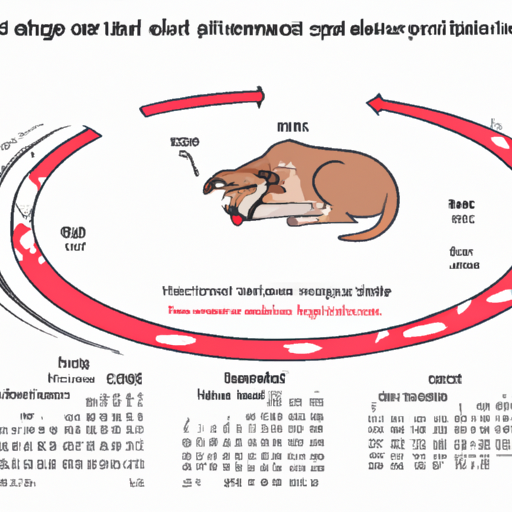As a caregiver for your four-legged friend, understanding your female dog’s reproductive cycle is crucial. One aspect that often raises questions and concerns is the bleeding cycle. It’s important to note that female dogs, unlike humans, do not menstruate monthly. Instead, they experience a cycle known as the estrous cycle, more commonly referred to as “being in heat”. In this guide, we’ll delve into the frequency, signs, and care needed during this period.
Understanding the Estrous Cycle
Female dogs usually experience their first estrous cycle between 6 to 24 months, depending on the breed and size. Smaller breeds tend to start earlier, while larger breeds may not have their first cycle until they are closer to 2 years old.
The estrous cycle typically happens twice a year, roughly every six months, but it can vary between breeds and individual dogs. It lasts about three weeks, during which your female dog will bleed. However, it’s not a continuous flow of blood but rather intermittent spotting.
Signs of the Estrous Cycle
-
Swollen Vulva: This is often the first sign. The vulva will return to its normal size once the cycle is over.
-
Bleeding: The bleeding usually begins a few days after the vulva starts to swell. The bleeding is not heavy like a human’s period. It’s closer to spotting and can range from light pink to dark brown.
-
Change in Behaviour: Some dogs may become more affectionate, while others may become irritable. You might also notice an increase in urination.
How to Care for Your Dog During the Estrous Cycle
During this cycle, it’s essential to provide the right care for your dog. Here are a few tips:
-
Keep Her Indoor: To prevent unwanted pregnancies, it’s best to restrict outdoor activities. Male dogs can smell a female in heat from miles away.
-
Use Doggie Diapers: To manage the bleeding, consider using doggie diapers. They can help keep your home clean.
-
Give Extra Attention: With the hormonal changes, your dog might require extra love and care.
The Importance of Spaying
Spaying is the surgical removal of a female dog’s reproductive organs. It’s a permanent solution to avoid the estrous cycle. Here are some benefits of spaying:
-
Prevents Unwanted Pregnancy: This is especially important if you have male dogs in the same household or if your female dog often interacts with other male dogs.
-
Mitigates Health Risks: Spaying reduces the risk of certain health problems, such as uterine infections and breast tumors.
-
Avoids the Mess: No more estrous cycle means no more dealing with bleeding.
Spaying should ideally be done before the first heat cycle, but it can be done at any age. Consult with your vet to determine the best time for your dog.
Frequently Asked Questions
1. Can I take my female dog for a walk during her estrous cycle?
Yes, but you need to be cautious. Avoid areas with other dogs and keep her on a leash at all times.
2. Is it necessary to spay my female dog?
While not mandatory, spaying has many health benefits and prevents unwanted pregnancies. It’s a decision that should be made considering your dog’s health, age, and lifestyle.
3. How long does the bleeding last?
The bleeding usually lasts for 7-10 days, but the entire estrous cycle lasts for about three weeks.
4. Does the estrous cycle cause pain to my dog?
Most dogs do not show signs of discomfort or pain. If you notice that your dog seems to be in pain, consult your vet.
5. Can I breed my dog during her first estrous cycle?
It’s generally not recommended to breed your dog during her first cycle. It’s better to wait until she’s physically matured, usually by her third cycle.
Understanding your dog’s reproductive cycle is an essential part of being a caregiver. By knowing what to expect and how to care for your dog during her estrous cycle, you can ensure she remains healthy and comfortable. Remember, when in doubt, always consult with your vet.



